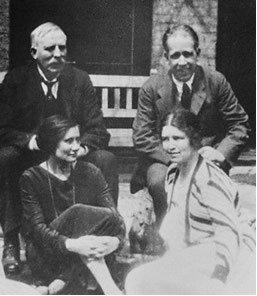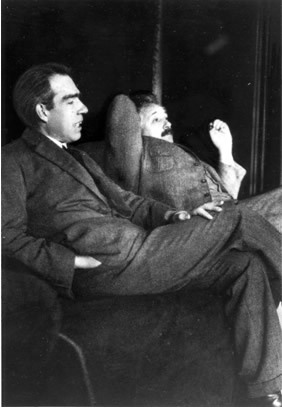Niels Henrik David Böhr was born in Copenhagen, Denmark, on October 7, 1885, and attended the University of Copenhagen. In the year 1911, he traveled to England to develop his post-doctorate, which was a thesis on the electronic theory of metals. Then he went to work with J. J. thomson, at Cambridge University, at the Cavendish Laboratory.
The following year he moved to Manchester to be part of the Ernest Rutherford, being, therefore, his assistant. Rutherford is said to have admired him greatly, even saying that Böhr had been the smartest person he had ever met.
This giant of science is best known for its atomic model, which was called the Rutherford-Böhr atomic model, as Böhr proposed a revolutionary atomic model that maintained, however, the main characteristics of the model previously proposed by Rutherford. To learn more about these two models, you can read the texts “Rutherford's Atom" and "Böhr's atom”.
But, in short, his atomic theory was based on the principle of quantization of energy proposed by Planck. He observed that elements, if heated, emit energy in a set of distinct lines called
line spectrum, and developed the idea that electrons can only exist in orbits limited to certain positions, with different energies. The electron only passes from one energy layer to the other when it absorbs energy from an external source, in discrete units of energy, called quanta. In this way, it jumps to an outermost orbit in the atom's electrosphere, and when it returns to the less energetic orbit, it loses, in the form of an electromagnetic wave, the energy it has absorbed before. This electromagnetic wave is in the visible region; so he explained the light emitted when heating different materials and the electromagnetic spectrum of hydrogen.Böhr published his atomic theory in the year 1913. Interestingly, he even postponed his honeymoon to write this work; but it was definitely worth it, as it earned him the Nobel Prize in Physics in 1922, at 37 years of age.

In 1912,Böhr married Margrethe Nørlund and had six children. It seems that genius has become a family thing; but unfortunately Böhr did not live to see his son Aage Niels Böhr be awarded the Nobel Prize in Physics in 1975.
Do not stop now... There's more after the advertising ;)
Niels Böhr became Professor of Theoretical Physics at the University of Manchester from 1914 to 1916, and then back to Copenhagen, in 1920 he became director of the Institute of Theoretical Physics.
In addition to the complex structure of atoms, he also studied the nature of X-rays, periodic variations in the chemical properties of elements, the structure of the atomic nucleus, and nuclear fission.
In 1940, Hitler's German forces occupied Denmark, including Copenhagen, where Böhr was. He was exiled to Sweden, where he took various initiatives on behalf of persecuted Jewish scientists, measures also against Hitler's tyranny, and helped many to actually escape death. However, he later transferred to the United States, where he became a consultant at the Los Alamos atomic energy laboratory, where several scientists channeled their efforts into the construction of the atomic bomb. This became known as Manhattan Project.
Below, we see a figure of Böhr with Einstein, both of which advocated the development of the bomb only as a means of containing the Nazi expansion. However, Niels Böhr realized the gravity of the situation and the danger of this bomb to humanity. So, in 1944, he abandoned the project and started defending the use of nuclear energy only for peaceful purposes. He even addressed the leaders of Churchill in England and Roosevelt in the United States, urging that this project not be pursued. However, their efforts were unsuccessful and on August 6, 1945, the first atomic bomb destroyed the city of Hiroshima, killing 66,000 people and injuring 69,000.

Niels Böhr then returned to Denmark, working as president of the Copenhagen Academy of Sciences until the date of his death, in November 1962, at the age of 77, a victim of thrombosis.
Until the end of his life, Böhr continued to fight against the use of nuclear weapons and so, in the year 1957, he received the Atoms Award for Peace.
By Jennifer Fogaça
Graduated in Chemistry


